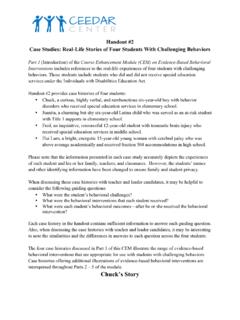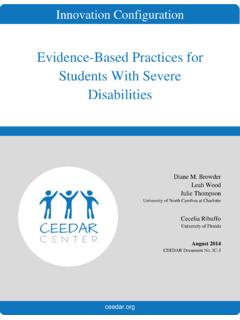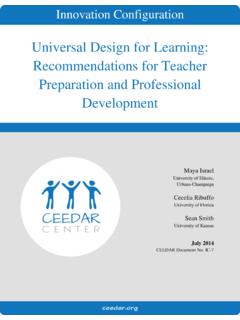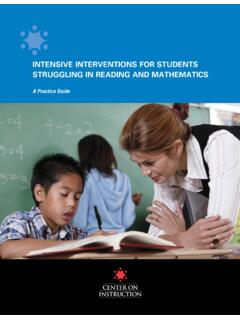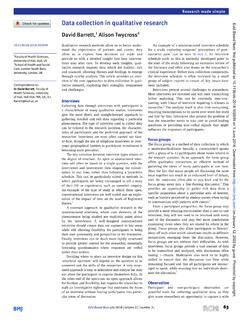Transcription of Handout 7 Examples of Evidence-Based Behavior …
1 Handout #7 Examples of Evidence-Based Behavior interventions Handout 3: Examples of Evidence-Based interventions is a part of the following module: National Center on intensive Intervention (February, 2014). Designing and Delivering intensive Intervention in Behavior . Washington, DC: Department of Education, Office of Special Education Programs, National Center on intensive Intervention. Retrieved from National Center on intensive Intervention Handout 3: Examples of Evidence-Based interventions 1 1132_01/14 Handout 3: Examples of Evidence-Based interventions example 1: Check In Check Out1 Check In Check Out (CICO) is commonly used because of the research base supporting the positive impact for students .
2 It is an excellent intervention when the function of Behavior is attention based . It is also a quick and easy intervention that requires minimal amounts of time before and after school and provides predictability and structure to a student s day. It increases the frequency of positive adult contact for a student that is structured to encourage, motivate, and support the student. CICO is an intervention with many names: You may know it as the Behavior Education Program; Check, Connect, and Expect; and Hello, Update, Goodbye (HUG). For whom should CICO be used? students engaging in problem behaviors that are not dangerous or severe (externalizing behaviors) Less than 15 percent of students students with multiple referrals (two to five major referrals) students who receive several minor referrals students who receive referrals in multiple settings students who find adult attention rewarding or reinforcing What are the characteristics of CICO?
3 students receive feedback from teacher several times per day (point rating) Increased feedback on Behavior 1 See also National Center on intensive Intervention Handout 3: Examples of Evidence-Based interventions 2 Increased praise Increased teacher contact A Daily Progress Report is used to monitor actions. What critical components must be implemented for CICO to be successful? Core elements of CICO Focus on teaching Check-in check-out system Daily classroom report card Home-school partnership Collaborative team- based process Collaborative team- based process A team of individuals reviews a student s progress on a regular basis.
4 Data are collected on an ongoing basis. Data are used to make decisions about the intervention s success (or lack thereof). Why does CICO work? Improved structure Prompts throughout the day for correct Behavior System for linking a student with at least one adult Increase in contingent feedback Feedback occurs more often and is tied to student Behavior Inappropriate Behavior less likely to be rewarded or reinforced Elevated reward or reinforcement for appropriate Behavior Adult and peer attention National Center on intensive Intervention Handout 3: Examples of Evidence-Based interventions 3 Linking school and home support Organized to morph into a self-management system example 2: Non-contingent Reinforcement2 Brief Description.
5 Understanding that students will engage in problem behaviors if they are reinforced, one strategy to minimize the utility of the Behavior is to saturate the environment with the reinforcer prior to the demonstration of disruptive Behavior . To understand why this intervention would be effective, think about a student who desires teacher attention and who has found that calling out in class consistently results in the teacher focusing attention on him or her (albeit, not in a positive manner). A non-contingent reinforcement (NCR) intervention directs the teacher to provide the student with attention (in this case, a more positive version) prior to the student asking with the problem Behavior .
6 As such, the student has no need to be disruptive and will hopefully, in time, prefer positive attention on a leaner schedule than negative attention on a more consistent schedule. This Handout presents a fixed time NCR delivery with extinction and schedule thinning as this version of NCR was found to have a well-established evidence base by Carr and colleagues (2008). Function of Intervention: NCR is a powerful method to reduce attention-seeking problem Behavior . NCR involves giving a student access to a reinforcer frequently enough so that he or she is no longer motivated to exhibit disruptive Behavior to obtain that same reinforcer. A classic example of NCR is a teacher placing a student on his or her lap during group instruction, such that a student has no motivation to seek the teacher s attention while the teacher is conducting, for example , story time with the class.
7 Carr et al. (2008) empirically demonstrated the effectiveness of such NCR interventions . In addition to being effective in reducing problem Behavior , NCR interventions have the distinct advantage of reducing problem Behavior with less of a chance of an extinction burst period. Because a student is already receiving as much of the reinforcer as he or she could want, there is no brief increase in disruption that commonly follows treatments that involve withholding reinforcement from the student. There is a rich literature base on the use of NCR. Two cautions are worth noting: When thinning the NCR schedule ( , reducing the amount of reinforcement a student gets), disruptive Behavior may re-occur, necessitating the use of extinction procedures.
8 Reinforcer substitution may occur, meaning the student may continue to exhibit disruptive Behavior to obtain other reinforcers. 2 Correspondence concerning NCR should be addressed to T. Chris Riley-Tillman, , at the University of Missouri (e-mail: National Center on intensive Intervention Handout 3: Examples of Evidence-Based interventions 4 Procedures: Identify the reinforcer for the inappropriate Behavior ( , verbal praise or escape). This may be a hypothesis that teams develop. Develop a fixed schedule to apply NCR for the target student. The goal of this step is to develop an initial schedule that is likely to catch the student before he or she engages in the problem Behavior , thereby making the disruptive Behavior unnecessary.)
9 Adapt the schedule based on the student s age, the student s developmental level, and the severity of the Behavior problem. For young students or those with severe Behavior problems, the initial NCR schedule will need to be very dense ( , once every 30 seconds). For higher functioning students with more mainstream Behavior difficulties, the NCR schedule can be less ambitious ( , once every 15 minutes). Implementers can easily determine how dense it should be by examining the frequency of disruptive Behavior that is followed by reinforcement in the classroom at baseline and ensuring that the schedule is more frequent at first. For example , if talking out occurs, on average, once every five minutes in the classroom, then NCR should be delivered in less than five-minute intervals.
10 When initially applying NCR, do not refer to the problem Behavior or note that the student is behaving inappropriately because the goal is to focus attention on neutral or positive Behavior , not the problem Behavior . After the NCR schedule has been initiated, do not respond to the target problem Behavior if and when it occurs (to focus attention on the positive or natural Behavior ). After a number of intervention days or sessions (for more severe cases) of applying NCR ( , five days or 20 25 sessions) and there is a marked reduction in the problem Behavior , start to thin out the reinforcement schedule. Thinning the schedule means reducing the frequency with which the student is provided reinforcement when NCR is in effect.
